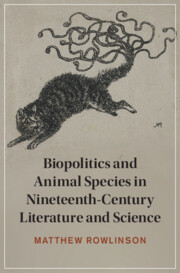Book contents
- Biopolitics and Animal Species in Nineteenth-Century Literature and Science
- Cambridge Studies in Nineteenth-Century literature and culture
- Biopolitics and Animal Species in Nineteenth-Century Literature and Science
- Copyright page
- Dedication
- Epigraph
- Contents
- Figures
- Preface and Acknowledgements
- Note on Citations
- Introduction Method and Field
- Part I Species, Lyric, and Onomatopoeia
- Part II How Did Darwin Invent the Symptom?
- Chapter 4 Darwin’s Unconscious
- Chapter 5 Foreign Bodies
- Part III Societies of Blood
- Notes
- Works Cited
- Index
- Cambridge Studies in Nineteenth-Century Literature and Culture
Chapter 4 - Darwin’s Unconscious
History, the Work of the Negative, and Natural Selection
from Part II - How Did Darwin Invent the Symptom?
Published online by Cambridge University Press: 11 January 2024
- Biopolitics and Animal Species in Nineteenth-Century Literature and Science
- Cambridge Studies in Nineteenth-Century literature and culture
- Biopolitics and Animal Species in Nineteenth-Century Literature and Science
- Copyright page
- Dedication
- Epigraph
- Contents
- Figures
- Preface and Acknowledgements
- Note on Citations
- Introduction Method and Field
- Part I Species, Lyric, and Onomatopoeia
- Part II How Did Darwin Invent the Symptom?
- Chapter 4 Darwin’s Unconscious
- Chapter 5 Foreign Bodies
- Part III Societies of Blood
- Notes
- Works Cited
- Index
- Cambridge Studies in Nineteenth-Century Literature and Culture
Summary
This chapter discusses Darwin’s lifelong interest in unconscious agency and instinct. Darwin typically treats instinct as a rational action that has become habitual and thus heritable; instinct embodies a cognitive process that does not know itself as such. His discussion of instinct is thus connected to other moments in his work where he uses the term ‘unconscious’; his treatment of previous taxonomists of species as unconsciously providing evidence for species transmutation, and his discussion of unconscious selection as an analogy for the effect of aesthetic preference in sexual selection. Darwin’s unconscious anticipates Freud’s as the embodiment of human agency in biological history.
- Type
- Chapter
- Information
- Publisher: Cambridge University PressPrint publication year: 2024

